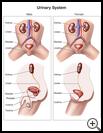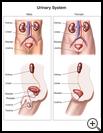
Voiding Cystourethrogram (Bladder Emptying X-ray)
________________________________________________________________________
KEY POINTS
- A voiding cystourethrogram (VCUG) is a test that uses contrast dye and X-rays to take pictures of the ureters, bladder, and urethra during urination to see how well the bladder and its connecting tubes, the ureters and urethra, are working.
- Tell your child’s healthcare provider if your child has had any kidney problems or reactions to iodine-containing foods or chemicals such as seafood or X-ray contrast dye.
- Ask your child’s healthcare provider how and when you will get your child’s test results and when your child can return to normal activities.
________________________________________________________________________
What is a voiding cystourethrogram?
A voiding cystourethrogram (VCUG) is a test that uses contrast dye and X-rays to take pictures of the ureters, bladder, and urethra during urination (voiding). It shows how well the bladder and its connecting tubes, the ureters and urethra, are working. The ureters are the tubes that drain urine from the kidneys to the bladder. The urethra is the tube that drains urine from the bladder to outside the body.
When is it used?
This test may be done:
- For your baby who is at least 48 hours old and has swelling of one or both kidneys or ureters (hydronephrosis or hydroureter), seen on ultrasound scan before and after birth
- For your child who is at least six years old and has vesicoureteral reflux, which is a backward flow of urine from the bladder up into one or both ureters. You child may have or had:
- One or more urinary tract or kidney infections with antibiotic medicine treatment
- Small, scarred, or swollen kidneys seen with ultrasound scan or other imaging
- Other problems with the structure of the kidneys, ureters, or the anus at birth
- A close relative with the same conditions
- A fever in a younger child
- For your child who has had surgery to repair one or both ureters
- For your child who has a weak stream when urinating, leaking or dribbling of urine, or a split or double stream of urine
- For your child who has these symptoms after an ultrasound scan and other tests do not show that the problem is caused by an infection:
- Lack of bladder control (incontinence)
- Not being able to empty his or her bladder
- Pain when urinating
Ask your child’s healthcare provider about your choices for treatment and the risks.
How do I prepare for this test?
- Your child may or may not need to take regular medicines the day of the procedure. Tell the healthcare provider about all medicines and supplements your child takes. Some products may increase the risk of side effects. Ask the healthcare provider if your child needs to avoid taking any medicine or supplements before the procedure.
- Tell the healthcare provider if your child has any food, medicine, or other allergies such as latex.
- Tell your child’s healthcare provider if your child has an allergy to chemicals such as contrast dye.
- Your child’s provider will tell you when your child needs to stop eating and drinking before the procedure. This helps to keep your child from vomiting during the procedure.
- Tell your child’s provider if your older child is or may be pregnant or is breastfeeding.
- Follow any other instructions your child’s healthcare provider may give you.
- Ask any questions you have before the procedure. You should understand what your child’s provider is going to do. You have the right to make decisions about your child’s healthcare and to give permission for any tests or procedures.
The procedure may be done in your child’s healthcare provider’s office, outpatient center, or hospital. Your child may be given medicine to help relax during the test.
Your child may be less afraid if you explain what will happen before the procedure. Depending on the age of your child, you may use books, demonstration, or dolls. You may be asked if you want to stay during this procedure to comfort your child. It’s a good idea to bring toys to help your child relax during the insertion of the catheter.
What happens after the test?
Your child can go home after the test is done. Your child's urine may be pink the first time your child urinates after the catheter tube is removed. This is caused by a small amount of blood in the urine. Your child may also cry and complain of pressure. Usually by drinking plenty of water or other clear liquids, your child will be able to urinate without a problem. If the child complains of a mild burning, place your child in a bathtub of warm, plain water to urinate.
Ask your child’s healthcare provider how and when you will get your child’s test results. Do not assume the results are normal if you do not hear from your child’s health care provider or the place that did your child’s VCUG.
Follow your child’s healthcare provider's instructions. Ask the provider:
- If there are activities your child should avoid and when your child can return to normal activities
- How to take care of your child at home
- What symptoms or problems you should watch for and what to do if your child has them
Make sure you know when you should come back for a checkup. Keep all appointments for provider visits or tests.
What are the risks of this procedure?
Every procedure or treatment has risks. Some possible risks of this procedure include:
- Your child may have an infection or bleeding.
- Rarely, your child may have an allergic reaction to medicines used during the procedure.
Ask your healthcare provider how the risks apply to your child. Be sure to discuss any other questions or concerns that you may have.
Last modified: 2022-01-03
Last reviewed: 2021-12-20


